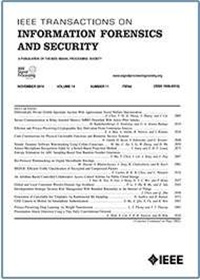针对深度哈希检索的目标攻击的全点制导对抗生成器
IF 8
1区 计算机科学
Q1 COMPUTER SCIENCE, THEORY & METHODS
IEEE Transactions on Information Forensics and Security
Pub Date : 2025-01-27
DOI:10.1109/TIFS.2025.3534585
引用次数: 0
摘要
深度哈希已广泛应用于图像检索任务,而深度哈希网络容易受到对抗性示例攻击。为了提高深度哈希网络的鲁棒性,有必要研究网络上的对抗性攻击,特别是针对性攻击。在现有的哈希目标攻击方法中,基于生成的目标攻击方法因其生成对抗性样例的效率而受到越来越多的关注。然而,这些方法仅使用正样本的哈希码来监督生成对抗样本,而没有使用训练集中所有点的哈希码直接参与监督训练,从而降低了攻击的有效性。由于训练集样本的哈希码是由训练良好的哈希模型生成的,因此这些哈希码保留了其对应样本的丰富语义信息,突出了充分利用的必要性。因此,在本文中,我们提出了一种利用训练集中所有点的哈希码直接指导生成对抗性攻击示例的针对性攻击方法。具体来说,我们首先对目标标签进行解码,得到相应的特征映射。然后,我们将特征映射与查询图像连接,并将它们馈送到采用跳过连接策略的编码器-解码器网络中以获得摄动样例。此外,为了指导对抗示例的生成,我们引入了一个损失函数,该函数利用了扰动示例的哈希码与训练集中所有点的哈希码之间的相似性,从而充分利用了这些哈希码中丰富的语义信息。实验结果表明,该方法在目标攻击有效性和可移植性方面优于当前的目标攻击方法。代码可在https://github.com/rongxintu3/APGA上获得。本文章由计算机程序翻译,如有差异,请以英文原文为准。
All Points Guided Adversarial Generator for Targeted Attack Against Deep Hashing Retrieval
Deep hashing has been widely used in image retrieval tasks, while deep hashing networks are vulnerable to adversarial example attacks. To improve the deep hashing networks’ robustness, it is essential to investigate adversarial attacks on the networks, especially targeted attacks. Among the existing targeted attacks for hashing, the generation-based targeted attack methods have attracted increasing attention due to their efficiency in generating adversarial examples. However, these methods supervise the generation of adversarial examples solely with the hash codes of positive samples, without employing the hash codes of all points in the training set to directly participate in supervisory training, thereby making the attack less effective. Since the hash codes of the training set samples are generated by a well-trained hashing model, these hash codes retain rich semantic information of their corresponding samples, highlighting the necessity of sufficiently utilizing them. Therefore, in this paper, we propose a targeted attack method that utilizes all points’ hash codes in the training set to guide the generation of adversarial attack examples directly. Specifically, we first decode the target label to obtain the corresponding feature map. Then, we concatenate the feature map with the query image and feed them into an encoder-decoder network that employs a skip-connection strategy to obtain a perturbed example. Furthermore, to guide adversarial example generation, we introduce a loss function that exploits the similarities between the perturbed example’s hash code and all points’ hash codes in the training set, thereby making sufficient utilization of the rich semantic information in these hash codes. Experimental results illustrate that our method outperforms the state-of-the-art targeted attack methods in targeted attack effectiveness and transferability. The code is available at https://github.com/rongxintu3/APGA .
求助全文
通过发布文献求助,成功后即可免费获取论文全文。
去求助
来源期刊

IEEE Transactions on Information Forensics and Security
工程技术-工程:电子与电气
CiteScore
14.40
自引率
7.40%
发文量
234
审稿时长
6.5 months
期刊介绍:
The IEEE Transactions on Information Forensics and Security covers the sciences, technologies, and applications relating to information forensics, information security, biometrics, surveillance and systems applications that incorporate these features
 求助内容:
求助内容: 应助结果提醒方式:
应助结果提醒方式:


